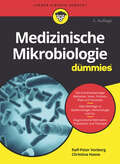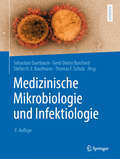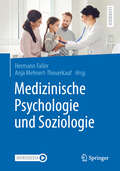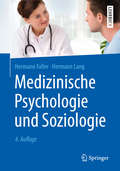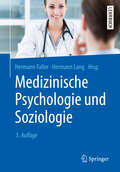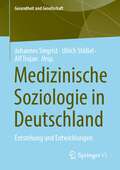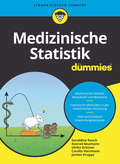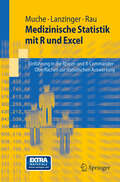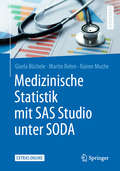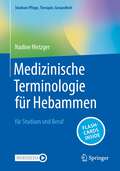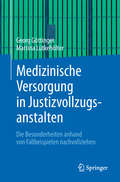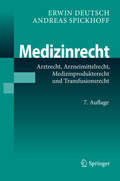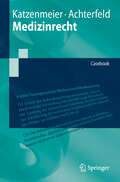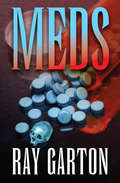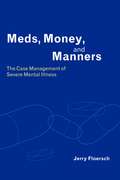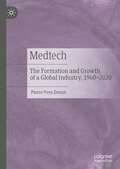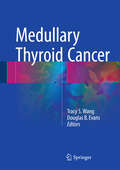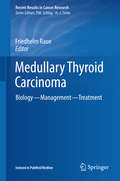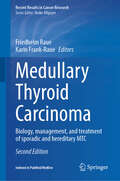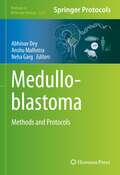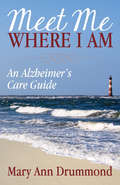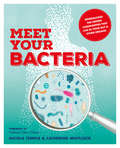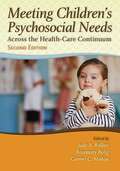- Table View
- List View
Medizinische Mikrobiologie für Dummies (Für Dummies)
by Ralf-Peter Vonberg Christina HaeseKokken, Stäbchen, Pilze, Viren, Prionen, Parasiten und Co. ? die Medizinische Mikrobiologie ist komplex und vielfältig. Aber keine Sorge, Ralf-Peter Vonberg und Christina Haese führen Sie Schritt für Schritt in die mikrobiologische Welt ein und erklären Ihnen alles, was Sie über pathogene Mikroorganismen und deren Bekämpfung wissen müssen. Dabei erläutern sie klar strukturiert das Wichtigste über Prävention, Diagnose und Behandlung von Infektionskrankheiten und richten sich dabei nach dem IMPP-Gegenstandskatalog.
Medizinische Mikrobiologie und Infektiologie (Springer-lehrbuch Ser.)
by Sebastian Suerbaum Gerd-Dieter Burchard Thomas F. Schulz Stefan H. E. KaufmannIn diesem Lehrbuch wird die medizinische Mikrobiologie von den allgemeinen Grundlagen über die Immunologie, die Diagnostik bis hin zur Chemotherapie dargestellt. Dabei sind die Kapitel zu den einzelnen Erregern besonders übersichtlich gestaltet. Um den klinischen Bezug deutlich zu machen, gibt es eine eigene große Sektion zu den Krankheitsbildern. Ein durchdachtes Konzept macht das Lernen leicht: Erreger-Steckbriefe zum schnellen LernenFallbeispieleZusammenfassungen am KapitelendeZahlreiche klinische AbbildungenEnge Vernetzung zwischen Erreger-Kapiteln und den Krankheitsbildern durch viele Querverweise Sämtliche Teilbereiche des Fachgebietes sind enthalten: Grundlagen, Immunologie, Diagnostik, Epidemiologie, Prävention, Hygiene, Bakteriologie, Virologie, Mykologie, Parasitologie, Chemotherapie, wichtige KrankheitsbilderDie HerausgeberProfessor Sebastian Suerbaum ist Vorstand des Lehrstuhls für Medizinische Mikrobiologie und Krankenhaushygiene am Max von Pettenkofer-Institut der Ludwig-Maximilians-Universität München Professor Gerd-Dieter Burchard ist tätig im Bernhard-Nocht-Institut für Tropenmedizin in Hamburg.Professor Thomas Schulz ist Direktor des Instituts für Virologie der Medizinischen Hochschule HannoverProfessor Stefan H.E. Kaufmann ist Direktor am Max-Planck-Institut für Infektionsbiologie in Berlin.
Medizinische Psychologie und Soziologie
by Barbara BrendelMedizinische Psychologie und Soziologie Mit diesem Buch erhalten Sie einen kompakten und vollständigen Überblick über alle prüfungsrelevanten Themen der Medizinischen Psychologie und Soziologie. Durch das neue farbige Layout können Sie Kerninhalte, Zusatzinhalte und klinische Inhalte schnell unterscheiden. Das Buch enthält sämtliche theoretischen und methodischen Aspekte für eine gelungene Arzt-Patient-Beziehung. Die allgemeine Anamnese und Gesprächsführungsmethoden werden dabei ebenso dargestellt wie spezielle Situationen z.B. in der Onkologie, Palliativ-, Sexual- und Intensivmedizin. Zu Fachbegriffen gibt es verständliche Erklärungen, zahlreiche Fallbeispiele aus der Klinik stellen den Bezug zur Praxis her. Und für den Wissens-Check stehen Ihnen jede Menge FlashCards zur Verfügung. Neu in der 6. Auflage: Neues vierfarbiges Layout Alle Abbildungen wurden überarbeitet FlashCards zur Prüfungsvorbereitung Ihre Lernhilfen: Lernziele am Kapitelanfang für einen schnellen Überblick Zahlreiche Klinikbeispiele Begriffserklärungen erläutern alle Fachtermini Die wichtigsten Fakten übersichtlich für die Prüfung in Boxen Zusätzlich vertiefende Hintergrundinformation und weiterführende Literaturtipps Die Herausgeber Prof. Dr. med. Dr. phil. Hermann Faller ist ehemaliger Leiter der Abteilung für Medizinische Psychologie und Psychotherapie, Medizinische Soziologie und Rehabilitationswissenschaften der Universität Würzburg. Prof. Dr. phil. Anja Mehnert-Theuerkauf ist Leiterin der Abteilung für Medizinische Psychologie und Medizinische Soziologie der Universität Leipzig.
Medizinische Psychologie und Soziologie
by Hermann Faller Hermann LangDieses Buch gibt einen Überblick über sämtliche theoretischen und methodischen Grundlagen der Psychologie und der Soziologie, die für die Arzt-Patient-Beziehung von Bedeutung sind. Die Situation des Patienten zu verstehen und adäquat auf ihn einzugehen, steht dabei im Zentrum. Besondere medizinische Situationen wie zum Beispiel aus der Onkologie, Palliativmedizin, Sexualmedizin und Intensivmedizin werden ebenso beleuchtet wie die Anamnese und Untersuchung. Das bewährte didaktische Konzept macht das Lernen leicht: Alle Themen aus dem GK sind enthalten, die wichtigen Prüfungsinhalte sind hervorgehoben. Der Text ist klar und einfach geschrieben und übersichtlich aufgebaut. Lernziele am Kapitelbeginn geben einen Überblick über das, was hängen bleiben soll. Definitionen, klinische Beispiele, Übersichten und Zusammenfassungen zum Wiederholen der wichtigsten Begriffe helfen beim Verstehen und Lernen. Und für die weiter Interessierten bieten die Exkurse und die kommentierten Literaturhinweise einen guten Einstieg. Die Autoren Prof. Dr. med. Dr. phil. Hermann Faller ist Leiter der Abteilung für Medizinische Psychologie und Psychotherapie, Medizinische Soziologie und Rehabilitationswissenschaften, Würzburg. Prof. Dr. med. Dr. phil. Hermann Lang ist ehemaliger Vorstand des Instituts für Psychotherapie und Medizinische Psychologie der Universität Würzburg.
Medizinische Psychologie und Soziologie (Springer-Lehrbuch)
by Hermann Faller Hermann LangDieses Buch gibt einen Überblick über sämtliche theoretischen und methodischen Grundlagen der Psychologie und der Soziologie, die für die Arzt-Patient-Beziehung von Bedeutung sind. Die Situation des Patienten zu verstehen und adäquat auf ihn einzugehen, steht dabei im Zentrum. Besondere medizinische Situationen wie zum Beispiel aus der Onkologie, Palliativmedizin, Sexualmedizin und Intensivmedizin werden ebenso beleuchtet wie die Anamnese und Untersuchung. Das bewährte didaktische Konzept macht das Lernen leicht: - Alle Themen aus dem GK sind enthalten, die wichtigen Prüfungsinhalte sind hervorgehoben. - Der Text ist klar und einfach geschrieben und übersichtlich aufgebaut. - Lernziele am Kapitelbeginn geben einen Überblick über das, was hängen bleiben soll. - Definitionen, klinische Beispiele, Übersichten und Zusammenfassungen zum Wiederholen der wichtigsten Begriffe helfen beim Verstehen und Lernen. - Und für die weiter Interessierten bieten die Exkurse und die kommentierten Literaturhinweise einen guten Einstieg.
Medizinische Soziologie in Deutschland: Entstehung und Entwicklungen (Gesundheit und Gesellschaft)
by Johannes Siegrist Alf Trojan Ulrich StößelDer Band soll ein Bild der Medizinischen Soziologie in Deutschland vermitteln: Entstehung, Themen, Einbettung in den Kontext der benachbarten Fächer und Versorgungsforschung. Dabei wird auf die Anfänge zurückgeblickt; der Schwerpunkt der Beiträge liegt jedoch auf aktuellen wissenschaftlichen Ergebnissen im jeweiligen Themenbereich.
Medizinische Statistik für Dummies (Für Dummies)
by Geraldine Rauch Jochen Kruppa Ulrike Grittner Konrad NeumannWenn auch Sie Ihre kleinen Problemchen mit medizinischer Statistik haben, sind Sie hier genau richtig. Mit viel Witz bringen Ihnen die Autoren Geraldine Rauch, Konrad Neumann, Ulrike Grittner, Carolin Herrmann und Jochen Kruppa die Prinzipien der Biostatistik näher. In diesem Buch lernen Sie alles, was Sie benötigen, um Statistik im medizinischen Bereich erfolgreich einzusetzen. Angefangen bei der Begriffskunde und den Grundlagen, erfahren Sie alles von Studientypen über deskriptive Verfahren, Verteilungen, Schätzungen oder Korrelation und Regression bis hin zur Ereigniszeitanalyse, diagnostischen Tests und multiplem Testen. Die Autoren bringen Ihnen das theoretisch vermittelte Wissen mit vielen anschaulichen Beispielen näher. So schaffen Sie die nächste Klausur mit Links!
Medizinische Statistik mit R und Excel
by Rainer Muche Michael Rau Stefanie LanzingerVielfach genutzt für die Verarbeitung von Daten in Tabellenform, war Excel bisher für statistische Analysen weniger geeignet. Seit 2009 kann mit dem Add-In RExcel die Statistiksoftware R eingebunden werden. Der Band bietet die erste Einführung auf Deutsch zur Benutzung der RExcel-Oberfläche. Anhand eines Beispieldatensatzes aus der Herz-Kreislaufforschung werden Deskriptive Statistik, Korrelation und Regression, statistische Tests, Überlebenszeitanalyse sowie Fallzahlplanung nachvollziehbar dargestellt. Mit Schritt-für Schritt-Anleitungen und Tipps.
Medizinische Statistik mit SAS Studio unter SODA
by Rainer Muche Gisela Büchele Martin RehmStatistische Auswertung - selbst gemacht!Der in dem vorliegenden Buch beschriebene Zugang über SAS® OnDemand for Academics (SODA) erlaubt einen kostenfreien, browser-basierten Zugang zur SAS-Software. Dabei können unter SAS Studio in einer menügesteuerten Oberfläche statistische Auswertungen ausgeführt werden. Die Oberfläche ist auch in einer deutschsprachigen Version verfügbar.Das Buch wurde so konzipiert, dass es sich hervorragend zum Selbststudium eignet. Zu Beginn wird eine Einführung in die Benutzung der SAS Studio Oberfläche gegeben. Anhand eines Beispieldatensatzes werden deskriptive Statistik, Korrelation/Regression, statistische Tests, Überlebenszeitanalyse sowie Fallzahlplanung mit zahlreichen Screen-Shots nachvollziehbar dargestellt. Eine Anleitung zur kostenlosen Registrierung von SAS-SODA ist ebenfalls enthalten. Darüber hinaus werden praktische Tipps zur Nutzung und Datenaufbereitung gegeben.So können Sie Ihre statistische Auswertung sicher und schnell selbst erledigen.Die AutorenDr. Gisela Büchele und Martin Rehm sind wissenschaftliche Mitarbeiter am Institut für Epidemiologie und Medizinische Biometrie, Ulm.Prof. Dr. Rainer Muche ist stellvertretender Institutsdirektor des Instituts für Epidemiologie und Medizinische Biometrie, Ulm.
Medizinische Terminologie für Hebammen: für Studium und Beruf (Studium Pflege, Therapie, Gesundheit)
by Nadine MetzgerDieses Lehrbuch richtet sich an Studierende der Hebammenwissenschaft und führt systematisch in die geburtshilfliche Fachsprache ein. Es vermittelt Grundlagen der lateinischen Sprache, um die anatomische Nomenklatur leichter lernen und behalten zu können, und erklärt die Prinzipien der klinischen Fachsprache. Kapitel zur Grammatik, kommentierte Vokabellisten und Übungen mit Lösungen helfen beim Verstehen. Infoboxen mit Zusatzinformationen zu bestimmten Begriffen aus Praxis, Wissenschaft, Geschichte und Mythologie machen das Lernen spannend und abwechslungsreich. Das Buch ist für das Selbststudium geeignet oder kann als Lehrmaterial im Unterricht eingesetzt werden.
Medizinische Versorgung in Justizvollzugsanstalten: Die Besonderheiten anhand von Fallbeispielen nachvollziehen
by Georg Göttinger Martina LütkehölterDas vorliegende Werk beschreibt anhand zahlreicher Fallbeispiele die Besonderheiten der medizinischen Versorgung in einer Justizvollzugsanstalt. Dargestellt werden die Grundlagen des ärztlichen Handelns und die medizinischen Tätigkeitsfelder im Justizvollzug ebenso wie die Thematik des Suchtmittelmissbrauchs und die Aufgaben der Fachaufsicht. Das Werk wendet sich an Ärzte aller Fachdisziplinen, die dauerhaft oder auch nur vorübergehend in einem Gefängnis arbeiten, z.B. im Rahmen des kassenärztlichen Notdienstes. Aber auch Psychologen, Anstaltsleitern und Vollzugsleitern bietet das Werk wertvolle Hinweise und einen praxisnahen Einblick.
Medizinrecht
by Erwin Deutsch Andreas SpickhoffJuristen, Ärzte, Pharmakologen und Apotheker finden in diesem Werk vier wesentliche Aspekte des Medizinrechts: das Arztrecht, das Arzneimittelrecht, das Recht der Medizinprodukte und das Transfusionsrecht. Die rechtliche Darstellung medizinischer, pharmazeutischer und medizintechnischer sowie transplantations- und transfusionsrechtlicher Probleme verdeutlichen Entscheidungen und praktische Fälle. Ein Blick auf ausländische Entscheidungen, Regeln und Tendenzen rundet das Bild ab. Europarechtliche Vorgaben werden eingehend beleuchtet. Die 7. Auflage setzt neue Akzente im Bereich des Transplantationsrechts, der Patientenverfügung und der Sterbebegleitung und zeigt neuere Entwicklungen in Europa im Recht der medizinischen Forschung, auch an Tieren. Wegen der genauen Gliederung und des ausführlichen Registers ist das Buch auch als Nachschlagewerk geeignet.
Medizinrecht: Casebook (Springer-Lehrbuch)
by Christian Katzenmeier Claudia AchterfeldDas Casebook präsentiert die prüfungsrelevanten Fragen des Medizinrechts anhand von über 50 ausgewählten Fällen und Lösungen. Neben den zentralen zivilrechtrechtlichen Themenkreisen werden verfassungsrechtliche, strafrechtliche, sozialversicherungsrechtliche und prozessrechtliche Probleme dargestellt und erörtert. Damit dient das Casebook nicht nur der Ausbildung im Schwerpunktbereich, sondern in weiten Teilen zudem der Vertiefung des Pflichtfachstoffs und Vorbereitung auf das juristische Staatsexamen.
Meds
by Ray GartonOne hot summer day, a man in a business suit running wildly down a busy street attacks a woman and her toddler, neither of whom have ever seen him before.... As he waits in his pickup truck for his wife to finish shopping, a man decides to take the shotgun off its rack, go inside the mall and open fire on total strangers.... While waiting to see her doctor, a woman takes a knife from her purse and begins stabbing others in the waiting room.Something is making people become violent and murderous...something they all have in common. When Eli Dunbar discovers what it is, he becomes afraid, because it's something he has in common with them-a drug prescribed to him by his psychiatrist. And now Eli is a ticking time bomb.Do you know all of the risks your prescription drugs might pose? Does your doctor? Or has the manufacturer hidden them from the public in the interest of profits?Meds...a thriller with deadly side effects.
Meds, Money, and Manners: The Case Management of Severe Mental Illness
by Jerry FloerschAs case management has replaced institutional care for mental health patients in recent decades, case management theory has grown in complexity and variety of models. But how are these models translated into real experience? How do caseworkers use both textbook and practical knowledge to assist clients with managing their medication and their money? Using ethnographic and historical-sociological methods, Meds, Money, and Manners: The Case Management of Severe Mental Illness uncovers unexpected differences between written and oral accounts of case management in practice. In the process, it suggests the possibility of small acts of resistance and challenges the myth of social workers as agents of state power and social control.
Medtech: The Formation and Growth of a Global Industry, 1960–2020
by Pierre-Yves DonzéThis book offers an analysis of the dynamics of the global medical device (medtech) industry from the 1960s until the present, using the approaches of business history and industry studies. While most of the publications in the corresponding field have focused on particular countries/regions or actors, this research is unique in its scope. First, it explores the formation and development of medtech business both globally and in the major countries engaged in this industry (the United States, Japan, Germany, Switzerland, France, and China). Second, it tackles a broad range of actors and organizations, from individual entrepreneurs, medical doctors, and engineers to small family firms, start-ups, and large multinationals, as well as universities and research centers. Hence, for the first time, this book both provides a general understanding of the formation and transformation of the medtech industry throughout the world and sheds light on the main features of a fast-growing business in the twenty-first century. This book will be of value to historians, industry professionals, and analysts.
Medullary Thyroid Cancer
by Tracy S. Wang Douglas B. EvansThis text provides a comprehensive, contemporary review of this disease and serves as an important resource for clinicians and researchers with an interest in medullary thyroid cancer. The book reviews the initial management of the patient with thyroid nodules, including risk factors, appropriate genetic evaluation of suspected/known medullary thyroid cancer, and appropriate screening for diseases associated with inherited forms of medullary thyroid cancer, including primary hyperparathyroidism and pheochromocytomas. It includes an in-depth discussion of the optimal surgical management of patients with sporadic and inherited disease, those with locoregional metastases, distant metastases, and recurrent medullary thyroid cancer. The long-term follow-up and management of patients with medullary thyroid cancer is highlighted. Medullary Thyroid Cancer will serve as a useful resource for all providers and researchers interested in this relatively rare and challenging malignancy. It highlights recent guidelines for the management of patients with medullary thyroid cancer and discusses controversies within the literature. All chapters are written by experts in the field and incorporate multiple disciplines, including Surgery (Endocrine Surgery, General Surgery, and Otolaryngology), Endocrinology, Radiology, Medical Oncology and Genetic Counseling.
Medullary Thyroid Carcinoma
by Friedhelm RaueThis book offers a comprehensive overview of medullary thyroid carcinoma, both in the more common sporadic form and in the familial form, multiple endocrine neoplasia (MEN) types 2A and 2B. The coverage includes, but is not limited to, molecular biology and genetics, pathology, clinical presentation, imaging techniques, surgical treatment, and follow-up. The role of calcitonin as a highly sensitive and specific tumor marker for the screening, diagnosis, and follow-up of MTC and metastatic disease is described, and the significance of other tumor markers is also considered. With regard to treatment, the use of thyroidectomy is fully discussed, including in children carrying the mutations in the RET proto-oncogene considered causative for MEN 2. Additionally, the value of tyrosine kinase inhibitors as the most effective treatment modality in patients with a large tumor burden or rapid tumor growth, or both, is explained. Medullary Thyroid Carcinoma and Multiple Endocrine Neoplasia Type 2 will be an ideal source of up-to-date information for a wide range of practitioners, including endocrinologists, oncologists, internal medicine specialists, geneticists, and nuclear medicine physicians.
Medullary Thyroid Carcinoma: Biology, management, and treatment of sporadic and hereditary MTC (Recent Results in Cancer Research #223)
by Friedhelm Raue Karin Frank-RaueAfter 10 years, this second edition is extensively rewritten and updated and provides a source of information concerning all aspects of medullary thyroid carcinoma, including comprehensive actual references for interested scientists. Medullary thyroid carcinoma (MTC) is a rare unique tumor which differs from other thyroid tumors by originating from the neuroendocrine C-cell, secreting the specific tumor marker calcitonin. MTC is associated in about 25% of cases with multiple endocrine neoplasia type 2, an autosomal dominant familial disorder causing tumors within various endocrine glands. The molecular genetics of tumor development is clarified: hereditary as well as sporadic MTC are linked to mutations in the RET proto- oncogene coding for a tyrosine kinase. These RET mutations serve as a genetic marker for hereditary MTC and allow for prophylactic thyroidectomy in gene carriers. The RET-tyrosine kinase is also a new therapeutic target using selective tyrosine kinase inhibitors improving the outcome of advanced metastasized MTC. This book will be an ideal source of up-to-date information for a wide range of practitioners, including endocrinologists, oncologists, internal medicine specialists, geneticists, and nuclear medicine physicians.
Medulloblastoma: Methods and Protocols (Methods in Molecular Biology #2423)
by Anshu Malhotra Abhinav Dey Neha GargThis volume details methods and protocols covering multiple aspects of Medulloblastoma. Divided into four parts, chapters guide readers through nucleic acids detection and analysis, cell-based analysis methodologies, and applications of patient-information on designing better experimental strategies for future drug development efforts in Medulloblastoma. Written in the highly successful Methods in Molecular Biology series format, chapters include introductions to their respective topics, lists of the necessary materials and reagents, step-by-step, readily reproducible laboratory protocols, and tips on troubleshooting and avoiding known pitfalls. Authoritative and cutting-edge, Medulloblastoma: Methods and Protocols aims to deliver a clear-cut and standardized set of protocols to a broad scientific community.
Meet Florence Nightingale - An eStory
by Charles MargerisonMeet Florence Nightingale, also known as The Lady with the Lamp. From a very young age, she was on a mission to care for others. She laid the foundations for the first nursing school and demonstrated amazing courage during the Crimean War, taking care of countless injured soldiers. Be inspired by her amazing story reflected in her BioView®.Each story comes to life through BioViews®. These are short biographical narratives, similar to interviews. They provide an easy way of learning about amazing people who made major contributions and changed our world.
Meet Me Where I Am: An Alzheimer's Care Guide
by Mary Ann DrummondMe Where I Am provides knowledge and essential tools to lovingly, confidently and, above all, successfully care for those who live with Alzheimer&’s and related dementias. Over 5 million Americans currently live with Alzheimer&’s disease. Along with them, 15 million unpaid caregivers seek knowledge and resources to assist them in the journey. The unique care principles found in Meet Me Where I Am help mitigate depression, decrease anxiety, and allow for successful relationships as long as possible in the dementia journey. Mary Ann Drummond, RN credits her unique care philosophy to the greatest teachers of all—the many individuals living with Alzheimer&’s and related dementias she has had the pleasure of caring for over the years. Imbuing practical tips with wisdom, respect, and sensibility, Drummond comes full circle by sharing what happened when her own mentor fell prey to the disease. Meet Me Where I Am is a road map that teaches caregivers how to focus on the possibilities, discover the joy in the journey, and prepare for the road ahead.
Meet Your Bacteria (Meet your...)
by Catherine Whitlock Nicola TempleMeet Your Bacteria introduces you to all of your tiny tenants, and reveals the fascinating inner workings of your body, and the importance of these usually helpful (but sometimes harmful) microbes.Highly topical and accessible, this book:- Explores the different bacteria that live on and in various parts of your body (not just in the gut)- Explains what they do, and why some are beneficial and some harmful- Offers practical advice for promoting the good and inhibiting the bad bacteria- Examines the latest thinking on good and bad dirt, and the links between bacteria and diseaseIncluding in-depth profiles on each of the most important families of bacteria living in the human body, and helpful advice on how you can look after your own health through greater knowledge of your microbial friends, this is a wide-ranging introduction to the secret world inside your own body.
Meet Your Bacteria: The Hidden Communities That Live In Your Gut And Other Organs (Meet Your... Ser.)
by Catherine Whitlock Nicola TempleMeet Your Bacteria introduces you to all of your tiny tenants, and reveals the fascinating inner workings of your body, and the importance of these usually helpful (but sometimes harmful) microbes.Highly topical and accessible, this book:- Explores the different bacteria that live on and in various parts of your body (not just in the gut)- Explains what they do, and why some are beneficial and some harmful- Offers practical advice for promoting the good and inhibiting the bad bacteria- Examines the latest thinking on good and bad dirt, and the links between bacteria and diseaseIncluding in-depth profiles on each of the most important families of bacteria living in the human body, and helpful advice on how you can look after your own health through greater knowledge of your microbial friends, this is a wide-ranging introduction to the secret world inside your own body.
Meeting Children's Psychosocial Needs Across the Health-Care Continuum
by Rosemary Bolig Judy A. Rollins Carmel C. MahanThis book captures the many developments in children's health care since the last edition, integrating current research and theory within the framework of a new and transitioning health-care environment. New to this second edition is the exploration of family and community issues and the impact on children’s psychosocial health and well-being. For, children in all settings continue to need nurturing, predictability, adequate stimulation, interaction, a sense of control, and mastery of their environments. The book concludes with an Epilogue that addresses trends in children's health care, providing thought-provoking ideas for new directions in psychosocial care of children and their families across the health-care continuum. E-Book Instructor's Manual is included with desk copy.
